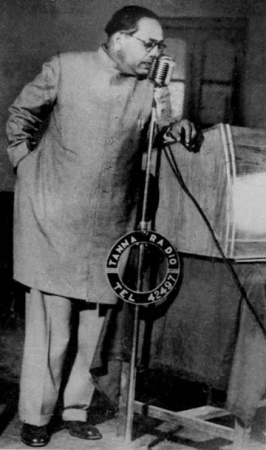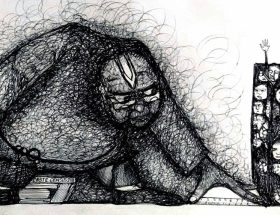Vinay Damodar & Jayram Waghchaure
Labor plays an important role in the socio-economic development of a country. 52.01 Crore (2017) people in the Indian population belong to the working class or workforce. Of this, 61.5 % population is directly dependent on agriculture. In India, 93% of the workforce works in the informal economy, while 7 % are in the formal sector. In such an economy, labor plays an important role.
After industrialization, many agricultural workers started shifting from agriculture to factory work and migrated to the cities for their livelihood options. The colonists, along with the capitalist class of India, started setting their own factories to earn profits from their manufacturing units. To earn more profits from the factories, the exploitation of laborers started. As most of the workers were uneducated and unaware of their rights, it was easy for owners to exploit them. There were no government regulations and or any protective measures in the interest of workers. As time passed, the need for labor laws in India grew, and in 1881, the British government passed the first factories act (The Indian Factories Act, 1881) to regulate factories in India.
Since then, Indian labor laws have seen many developments from time to time. At present, we have more than 50 Central laws and hundreds of state laws on labor and employment matters. The constitution of India also gives various safeguards to the Indian labor force through fundamental rights and the Directive Principles to State Policy (DPSP). ‘Labor’ under the ‘Concurrent’ List i.e., both the state government and central government can make the laws on the issues related to labor.
Whenever we talk, listen, read or write about Indian labor welfare and labor laws, we directly jump to the legislations. If someone is to be quoted for their contribution to the empowerment of labor and work related to them, only a few names feature in the list: Dattaji Meghaji Lokhande, M.K. Gandhi, and Mr. Datta Samant. However, we rarely come across any reading or academic discussions on the contribution of Dr. Bhimrao Ambedkar in this area. However, it is worth noting that he served on the Viceroy’s Executive Council for four years, from 1942 to 1946, and was in charge of the Labor portfolio. In the years that followed, he also served as a Labor Minister. In the first independent Indian government, he served as the Law Minister. While serving in all of these positions, he made significant contributions to labor legislation and the betterment of Indian labor.
‘Labor’ in the Constitution of India
Being the chief architect of the Indian Constitution, Dr. B. R. Ambedkar has safeguarded the rights of Labor. Labor is a subject in the ‘Concurrent List’ under the Constitution of India where both the Central and State Governments are competent to enact legislations subject, however, to reservation of certain matters for the Central Government. The constitutional status of labor jurisdiction has been explained in the following table:
| Union List (Central Govt.) | Concurrent List (Central as well as state govt.) |
| Entry No. 55
Regulation of labor and safety in mines and oil fields |
Entry No. 22
Trade Unions, Industrial and Labor Disputes |
| Entrée No. 61
Industrial Disputes concerning Union employees |
Entrée No. 23
Social Security and Insurance, employment and unemployment |
| Entry No. 65
Union agencies and institutions for Vocational Training |
Entrée No.24
Welfare of labor including conditions of work, provident funds, employers invalidity and old-age pension and maternity benefits |
Dr. Ambedkar’s work has always been seen as limited to constitution writing and the advancement of Dalits in India. However, in addition to these two significant tasks, he had also worked in other areas. Labor was one of the most important areas on which he concentrated his efforts throughout his life. In one of his writings, ‘Castes in India,’ he stated that caste is not a division of labor but a division of laborers. In this essay he raised the issue of labor, not from the perspective of labor welfare, but from the perspective of the origin and genesis of labor through the caste system.
Independent Labor Party
In 1936, Dr. B.R. Ambedkar founded the Independent Labor Party. Other key members during the party’s formation were Dadasaheb Gaikwad, D.V. Pradhan, Chitre, Tipnis, and others. Dr. Ambedkar’s main intention for forming this new party was that according to him, the Congress was not a party of poor people, but rather of wealthy businessmen, factory owners, landlords, and the capitalist class. The poor and rich classes’ purposes are not the same, and they can be diametrically opposed at times. So many laws had to be passed in the legislative assembly following the elections under the Government of India Act of 1935. If Congress had a monopoly in the Assembly, the nature of the laws could be beneficial to the rich and sometimes harmful to the poor. The establishment of the Independent Labor Party was required to protect the interests of the poor.
According to Admiral Vishnu Bhagwat, Dr. Ambedkar formed the Independent Labor Party on three fundamental/basic principles:
- First: All the wealth, property and assets in this world are the result of undying hard labor of the workers and the farmers. Despite this, the worker and the farmer who toils with desperation in the field is naked and hungry. All these riches, property and the means of production have been appropriated by private property rights arbitrarily imposed by the profiteers, landlord class, capitalists and the rich class who have cornered all wealth through illegal/unjust loot, robbery and theft.
- Second: Indian society is divided into the class ruled over and the ‘ruling class’, whose interests. Their interests clash as a class conflict between the ‘Ruler-Exploiter’ and the ‘Ruled Exploited’ is fundamental element of society.
- Third: The rights of workers and toilers can be defended and will be secured only when the reins of political power are in their own hands.[1]
Programme of Independent Labor Party
Provincial autonomy was established in 1937 under the Government of India Act of 1935. All political parties had now begun their preparations for elections. For the same purpose, Dr. Ambedkar had to draw up a comprehensive programme for his newly formed ILP, which concentrated on all the immediate needs and grievances of the landless poor tenants, agriculturists and workers.
The programme included the following points :
(1) State-sponsored industrialization was given high priority, resulting in the rehabilitation of old industries as well as the establishment of new ones.
(2) It advocated for an extensive programme of technical education and the principal of state management and state ownership of industries where necessary.
(3) It demanded strong labor laws to protect factory workers, as well as legislation to provide remunerative wages, set maximum hours of work, provide paid leave, and provide workers with affordable and sanitary housing.
(4) Proposal for village planning regarding sanitation and housing, and to modernize the outlook of villages and intended to furnish villages with halls, libraries and rotary cinemas.
(5) Protection of agricultural tenants from exactions and evictions by the landlords.
(6) Need for penalizing all forms of orthodoxy and reactionary behaviour.
(7) To use surplus from charity funds for purposes such as education.
The ILP emphasized the need for the welfare of poor workers and peasants. Its formation was not welcomed by the Communist leaders as they argued that it would lead to a split in the working class voters. But Ambedkar replied that communist leaders were working for the rights of the workers but not for the human rights of Dalit workers. (Kalsi, 2016)
Dr Ambedkar’s work on Labor Legislations
Dr. Babasaheb Ambedkar joined as a member of the Viceroy’s Executive Council on the 20th July 1942. He was tasked with managing the labor portfolio. As a member of the Bombay Legislative Council and the Viceroy’s Executive Council, his contribution to labor legislation in India was immense.
Dr. Babasaheb Ambedkar, as the Labor Minister in New Delhi on the 6th and 7th of September 1943, defined the labor demands for food, clothing, shelter, education, cultural amenities, and health resources in a very impressive speech.
The factories Act was amended three times during Dr. Babasaheb Ambedkar’s tenure as a labor member, two of which were significant. In April 1944, he moved a bill proposing holidays with pay for industrial workers employed in perennial factories. The second amendment, passed on April 4, 1946, restricted the daily and weekly hours for laborers. (Nagar V.D. Nagar K.P. 1992.P140)
During his tenure as a labor member, he enacted legislation establishing a labor welfare fund. The money set aside as a welfare fund was to be used for the welfare of the labor and their families. For this, he proposed five labor welfare funds for five different types of work. These include labor welfare funds for coalmines, iron industries, manganese ore industries, mica mines and beedi workers. Additionally, money from these funds was to be used primarily in areas such as education, health care services, and providing workers with housing. Currently, the government of India has implemented several new schemes for Indian workers, such as PPF, bonuses, and allowances. All these scheme are the brainchild of Dr. Babasaheb Ambedkar. During the same time period, Dr. Ambedkar, while serving as a labor member, amended the Mine Maternity Benefit Act of 1941 twice and included pro-woman provisions for the betterment of the female workforce.
Dr. Ambedkar introduced a new bill in the legislative assembly in 1946, relating to the minimum wages to be paid to workers with respect to their working hours in the working premises. This bill included provisions for uniform minimum wages to be set by the government, with each worker entitled to at least that amount of pay. Wages less than that amount were made illegal. A provision was also made to revise these minimum wages every five years. In today’s time, the same laws are followed for minimum wages; the bill became an act in 1948 and is now known as the Minimum Wage Act, 1948.
Under the Factories act, he made provisions with amendments that provided workers with 10 days of paid leave from work for adults and 14 days for child workers. Along with this, provision for availing compensatory leave was also made available in case of unutilized paid leaves. He was the one who made the provision for overtime pay. Under this, if a worker works more than 8 hours per day or more than 48 hours per week, he is entitled to overtime pay from his employer for the extra hours worked. Furthermore, he suggested that the overtime wage rate must be higher than the regular wage rate. Also, the provision of maximum working hours per day and per week was also the brainchild of Dr. Ambedkar. The same is being followed today.
Women’s empowerment has always been a concern and central idea in Dr. Babasaheb Ambedkar’s work. Women’s role in the development of a nation is critical. Women’s development will determine a nation’s capability. In this regard, Dr. Babasaheb Ambedkar played an important role in the advancement of women. “I measure the progress of a community by the degree of progress which women have achieved,” he said. It was Dr. Babasaheb Ambedkar who made an important contribution to elevating the status of women in India in terms of labor welfare; he has also worked for the benefits of women. In this regard, he introduced the Mines Maternity Benefit Act of 1941 to provide benefits to pregnant women and allow them to get rest during childbirth and the early days of child care. According to the act, the benefit period for maternity leave was increased to 16 weeks, which could be split in two so that a woman worker could take 10 weeks leave before confinement and 6 weeks after confinement. The provisions for receiving full wages during this maternity leave period were made, and this must be paid solely by the employer. No woman can be fired or lose her job during her pregnancy; if this occurs, it is considered illegal in a court of law. This enables women employees to get adequate rest during their pregnancy and to continue working after giving birth. As a result, women began to return to work after having children, increasing their workforce participation rate.
Dr. Babasaheb Ambedkar was of the opinion that workers had the right to strike, but that the weapon of strike should be used sparingly and to the benefit of the worker rather than for the political objectives of the party. In today’s world, every trade union uses the strike weapon to achieve political goals and becomes a roadblock in the development process. He had proposed that an all-India labor federation be formed to devise a policy that could be applied uniformly to all working classes and government employees. Dr. Babasaheb Ambedkar was opposed to various trade unions for each department, such as postal and telegraph union, railwaymen’s union, textile union. Because of separate unions, the problems of labor are not solved and their demands are not fulfilled by the government. (Govt, of Maharashtra, 1991, P.245)
Labor Policy
For the development of a nation state, labor culture is important. Labor cultures of China, Japan, Germany are different from India. Lack of strategic and development vision would create problems for security and unity of the nation. When we look back, we can see that the government of India’s labor policies are directly related to Dr. Babasaheb Ambedkar’s policies.
Most of the current policies and programs related to the labor ministry are nothing but the ideas given by Dr. Babasaheb Ambedkar while serving as a member of Viceroy’s executive council. The government has already started an expenditure cut in labor programs. Curtailment of public expenditure and withdrawal of subsidies may have significant repercussion on the employment situation and welfare of vulnerable sections. The recent NSSO report on unemployment for March 2019, which shows that two crore employees have lost their jobs in the last five years, is shocking news for the entire Indian labor market. For security and stability of labor market it is important to provide better opportunities and security benefits to laborers and employees. The relationship between labor unions, employers and the government needs to be strengthened. For the security of the nation, labor welfare should be maintained by providing proper basic facilities and avoiding any conflict between labor and management or workers and management.
It is important to adopt the ideas of Dr. Ambedkar for the development labor in order to strengthen it. His ideas–on providing workers with safeguards and social security measures, giving workers equal opportunity to participate in the formulation of labor policy, and strengthening the labor movement by introducing compulsory recognition of trade union in order to enable labor to play an effective role in the economic development of the country–are significant. Many things have changed in the last 15-30 years since the introduction of Liberalization, Privatization, and Globalization (LPG) policy. The demands of labor have changed. Mechanization and advancement of machinery in the factory premises is changing the working style and nature of work. Majority of the workforce is moving towards the service sector. In spite of changes at the global or national levels, Dr. Babasaheb Ambedkar’s ideas for labor policy, such as the Group Insurance Scheme, Compulsory Insurance Scheme, and so on, will continue wield positive influence. These policies are important in terms of developing healthy human resources, which can help our industries and agricultural production by providing higher-quality input.
In this drastically changing business environment, commercialization and privatization of industries in India may halt the process of development of Indian labor. But it’s important and challenging to the nation to uphold the welfare of labor first, and then think of the pace of development. If we wish development of our people i.e., if we develop our labor force by securing their rights and providing welfare benefits to them, it will result in the human development or human resource development of the country and ultimately the development of the nation. In this regard, the ideas, thoughts and vision of Dr. Babasaheb Ambedkar on labor welfare need to be revisited and implemented as the situation demands.
~
Notes
[1] http://shodhganga.inflibnet.ac.in/bitstream/10603/134780/9/09_chapter%203.pdf)
References
(1991). Dr. B.R. Ambedkar: Writings and speeches. Mumbai: Government of Maharashtra.
Kalsi, A. (2016). Ambedkar’s Independent Labor Party: Emancipation of Dalit. International Journal of business Management and Scientific Research.
Laxmikanth, M. (2016). Indian Polity. Delhi: McGraw Hill .
Padhi, P. K. (2017). Labour and Industrial Laws. PHP Publication.
~~~
Vinay Damodar & Jayram Waghchaure
Both are Ambedkarite Research Scholars currently Pursuing Ph.D. in Inclusive Development and Social Justice, from Centre for Study of Social Exclusion and Inclusive Policies, Tata Institute of Social Sciences Mumbai.










